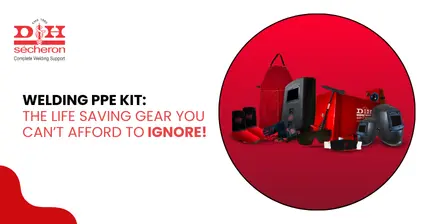Weathering steel belongs to the group of low carbon steels. The alloy elements like copper, chromium, silicon and phosphorous in these steels are mixed with carbon and iron atoms.
Let’s tell you more about what is weathering steel and how you can use it in welding.
Weathering steel refers to a type of steel alloy with superior yield strength capability. Its chemical composition makes it highly resistant to corrosion caused by weather and atmospheric conditions such as air and moisture. It develops a paint-like, protective oxide layer (iron oxide or rust) called ‘patina’ on its surface which makes it corrosion-resistant. It will form rust only on the outer surface. This surface layer doesn’t allow the rust to penetrate deeper into the weathering steel and thereby, protects against corrosion.
Weathering steel is also known as corten steel. It was registered under the trademark Cor-Ten which was originally developed and patented by U.S. Steel in 1933. Cor-Ten gets its name from two words – CORrosion Resistance and TENsile Strength. However, the American Society for Testing and Materials (ASTM) standardised it as a product later.
Corten Steel Uses and Applications
Corten steel is used for both practical and visual appeal reason in the following applications:
Engineering projects
Architectural projects
Construction of buildings and bridges
Outdoor sculptures
Marine transportation
Roofs and walls
Cycle hoops
Planters
Tree grilles
Corten Steel Texture
The texture of corten steel is rusty with an orangish-brown shade. Due to corten steel texture seamless, it often gives an aesthetic finish to the product or application wherever it is used. Welders can apply it seamlessly without worrying about mixing the right proportions of various chemicals to get a rusty appearance.
Corten Steel Properties
Corten steel has the following properties:
Anti-corrosive
Robust metal
Ductile
High structural strength
Lightweight
Attractive appearance
Minimal upkeep
Corten Steel Specification
The primary trademark product is COR-TEN. However, ASTM has also laid down specifications as under:
A588 (structural weathering steel panels, shapes, plates and bar)
A242 (steel plate through 1.5 inches in thickness)
A606-4 (corten steel sheet and coil)
A847 (tube and pipe)
A871-65 (steel plate with a minimum yield strength of 65ksi)
A709-50W (steel plate for construction of bridges)
The weathering steel grades are available as corten A and corten B. For example, A242 is corten A and A588 is corten B.
Corten Steel Prices
Corten is an expensive metal as compared to other grades of steel. It comes in different grades, properties and specifications. Hence, the prices vary from one weathering steel manufacturer to another.
Welding on steel that is corten is relatively as similar as low carbon steel. The only precaution the welders need to take is regarding the filler or electrode which is different from mild steel. When it comes to choosing a welding electrode for weathering steel, AWS E7018 is most suitable. The choice of electrode depends on two factors - required strength and code requirements.
Corten steel has been the most widely-used metal for decades owing to its look and benefits. It overcomes rust, which is the major drawback associated with steel. The necessary expertise and experience in welding already exist. Hence, welders should be able to use it without any hassles.
11 May 2025 | Welding
An In-Depth Exploration of Low-Alloy Steel: Your Comprehensive Guide
11 May 2025 | Welding
Nagpur - Bori - Tuljapur Road MSH-3 in Yavatmal District (Maharashtra)
11 May 2025 | Welding
Guidelines to Understand Gas Welding: Applications, Advantages & Disadvantages
11 May 2025 | Welding
3 Tips for Finding the Best Mild Steel Electrode for Your Application
11 May 2025 | Welding
How to Select the Right Welding Filler Wires for Stainless Steel Welding?
11 May 2025 | Welding
Building the Narendra Modi Stadium with Norma V and Autotherme-1 Electrodes
11 May 2025 | Welding
Low Alloy Steel Welding in a (PEB) Pre Engineered Building Structure
11 May 2025 | Welding
Welding Rods: Different Types and Tips for Properly Storing and Handling
11 May 2025 | Welding
Tips for Flawless Welds with Stainless Steel Electrodes: Pros and Cons
11 May 2025 | Welding
Exploring Applications and Benefits of Stainless Steel Welding Electrodes
11 May 2025 | Welding
Welding Basics: Joining Metals with Heat and Pressure - A Beginners Guide
11 May 2025 | Welding
Distinguishing Low-Alloy Steel from High-Alloy Steel: Understanding the Variations
11 May 2025 | Welding
Hard Facing Wire - Understanding the Process and Achieving Optimal Result
11 May 2025 | Welding
Exploring the Advantages of Stainless Steel Electrodes in Welding Applications
11 May 2025 | Welding
Weathering Steel vs. Traditional Steel: A Comparative Analysis of Performance
11 May 2025 | Welding
Choosing the Right Welding Rod: Why 6013 Electrodes Might Be Your Ideal Option
11 May 2025 | Welding
Why 7018 Electrodes Are Preferred for High-Strength Welds in Pipeline Construction
11 May 2025 | Welding
Filler Wire vs. Stainless Steel Filler Wire: Understanding the Key Differences
11 May 2025 | Welding
Exploring the Impact of Filler Material on Welding Quality and Durability
11 May 2025 | Welding
Choosing the Right Cast Iron Electrode for Different Welding Projects
11 May 2025 | Welding
Top Advantages of Cast Iron Electrodes for Industrial Welding Applications
11 May 2025 | Welding
Key Benefits and Challenges of Using TIG Welding in Industrial Projects
11 May 2025 | Welding
5 Reasons Why 7018 Electrode is the Gold Standard for Welding Professionals
11 May 2025 | Welding
Top 5 Advantages of Flux Cored Arc Welding for Heavy-Duty Applications.png)
11 May 2025 | Welding
Lotherme-601: A Game-Changer for Restoring Shoulder Pins in Heavy Machinery
11 May 2025 | Welding
How D&H Sécheron Helped Repair a Rotary Kiln’s Cooler Section with LoTherme 352
11 May 2025 | Welding
Piston Repair for Mining Industry: Cost-Effective Solutions with LoTherme 468.webp)






.jpg)







































.jpg)
.jpg)

.jpg)

.jpg)





.jpg)
.jpg)
.jpg)



.webp)
.jpg)
.jpg)
.webp)
.jpg)






















.png)



.webp)

.webp)
.webp)



